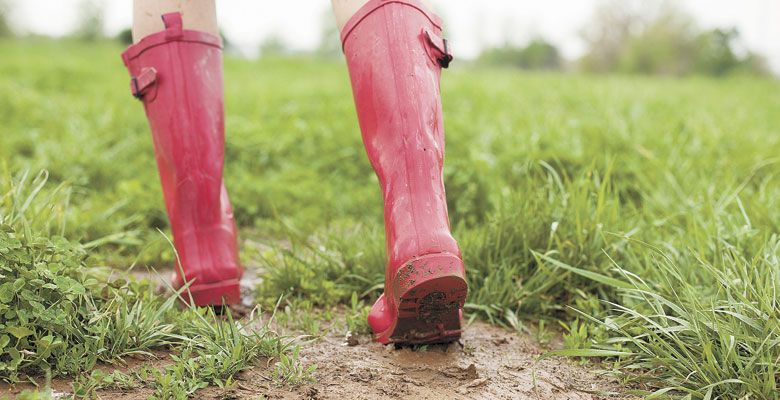Women’s Work
Wine industry built on female tenacity
Fall in wine country always brings memories of mud on my boots.
In 1972, I lived on the current site of Torii Mor Winery with my parents, two Cairn Terriers and a lot of red dirt — the muddy dogs would cake the well-intentioned newspapers meant to protect the floor. We lived in a travel trailer while planting the vineyard and building the family home in the Dundee Hills. My mother, Donna Jean McDaniel, recalled, “It was not glamorous vineyard living!”
Vineyard life was like a moody Moorish poem, with the wind rustling through the mossy oaks during the dark night and the fog settling like a gray blanket over the rows in the cool fall morning.
My independent mother, undaunted by the many challenges of the fledgling wine industry, was one of many strong women in those early days, reminding me of Ann Richards’ famous observation: “After all, Ginger Rogers did everything that Fred Astaire did. She just did it backwards and in high heels.” Of course, they wore boots, not heels, tromping through the vineyard, no less making their mark from the beginning.
These women forged a legacy of hard work and perseverance, of rising early to take care of needs on the vineyard, or in the winery office, juggling the demands of motherhood, developing a burgeoning industry for their daughters and families that continues today.
Many traded cul-de-sac living for a rural version, partnering with their spouses to work the land and start their vineyard ventures. Eventually, the sacrifices paid off as many of these families still grace the current Oregon wine industry and with second-generation daughters at the helm — Nancy Ponzi with daughters Louisa and Maria, Ponzi Vineyards; Trudy Kramer and daughter Kim, Kramer Vineyards; Lois Maresh and daughter Martha, Arterberry-Maresh/Powell Hill Winery; Pat Campbell and daughter Anna, Elk Cove Vineyards; Susan Sokol Blosser and daughter Allison; Pat Dudley and daughters Mimi and Jessie, Bethel Heights; Carolyn Chambers and daughter Liz, Sylvan Ridge Winery/Elizabeth Chambers Cellar.
The list goes on.
Throughout the 1970s and ’80s, my mother and other women worked from the vine to the bottle — plotting, planting, harvesting, crushing, bottling, selling — and everything in between to establish an industry now boasting more than 700 wine labels.
Being a part of a fledgling industry had its challenges.
My mother plotted the entire 14-acre vineyard by hand with a ruler. She strung miles of one-inch wire around the living room, marking the cable every six feet with a blue marker; every ten feet she put a yellow mark, designating where to put the stakes — getting a straight line wasn’t easy.
“The mathematics it took to mark cable for 50-foot rows was incredible,” she recalled.
C.J. David, a 30-year wine industry veteran married to Dick Erath, recalls planting her vineyard in Southern Oregon wearing a baby strapped to her chest and a toddler in a backpack.
“You did what you had to do, every day, to take care of your babies while simultaneously tending the vines — your other ‘babies’ — and establishing your winery,” recalled David, three decades later.
In 1983, Trudy Kramer and her husband, Keith, founded the eponymous Gaston-area winery near Elk Cove. She has managed the daily tasks from accounting to winemaking since the winery’s inception. Their daughter, Kim, joined the team in 2009 after working at St. Innocent and in Burgundy.
Trudy Kramer noted the advent of two local laboratories for winemakers to access technical support has been the crucial difference between her experience in the early years and her daughter’s current winemaking options, including various choices of yeast and techniques to soften tannins. Also, the variety of clones was limited versus the abundant clone choices today.
“We only had three clones when we started; they are called heritage clones now: Pommard, Wadenswill and Gamay Beaujolais,” Kramer said. “And what we used as wine glasses was laughable before Reidel came in and showed us the difference in the taste of wines. We didn’t realize that the shape of the glass could have such an effect on the taste and aroma of wines.”
Glory also to the women who forged on after monumental loss.
Anna Wisnovsky and her husband, Frank, founded Southern Oregon’s Valley View Winery in 1972, the first commercial winery in the Rogue Valley since Prohibition. When Frank died in a 1980 construction accident at Lost Creek Dam, Anna vowed to continue the dream with her four young children. Today, Valley View Winery thrives in its second generation, producing Southern Oregon varietals consistently for four decades, including a Cabernet Sauvignon produced every year of operation.
Joan Davenport, founder of Wine Country Farm and the Armonéa label, was succinct in her description of the tenacity necessary for survival on a vineyard. She established her bed and breakfast in a run-down farmhouse in 1990 near Dayton. Her daughter, Sherri Harkness, still runs the operation with her brother.
During a speech at a Women of Willamette gathering, Davenport, who succumbed months later from cancer, offered this gem, “My life’s journey has always been traveled my way — my direction, my road, my speed. Sometimes that single-mindedness has caused tension or friction. Even close friends and family have probably felt at times that I was being stubborn. I prefer to call it determined. Strong. Stubbornness is a fault to which I do not subscribe. I do, however, admit to determination.”
Kudos to all the women who have made their mark in our state’s wine industry. You deserve to kick off your boots, pour yourself a glass — or two — and celebrate the many important contributions you’ve made.










